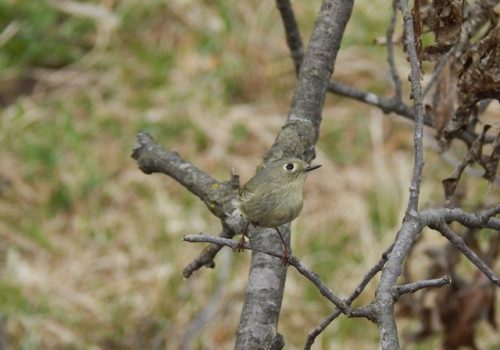Calling Things by Their Names
Summer 2024
by Lisa
This past Easter, Julian and I made a retreat at Our Lady of Guadalupe Trappist Abbey. On our last day before leaving the beautiful grounds, we walked around a pond while Julian held his cell phone in the air, using his bird identification app to identify the unique birdsongs sounding around us. I love Julian’s attention to birds, and his influence is rubbing off on me. That morning, I learned the name of one of the birds we heard, a Ruby Crowned Kinglet—what a royal name!
The diversity of birds and the names we give them struck me in a new way—each bird we name is a unique creature, with a unique song, and not just “a bird.” I felt invited to a new way of seeing, and how learning the different names of birds is a path to intimacy, to entering into a more personal relationship with creation. It was as if I was getting to know my non-human neighbors in a similar way to how we first share our names when introducing ourselves to someone we don’t know.

I am also aware that there is a dark side to naming, too, that we can project our own assumptions and interests through naming, in a kind of power-over name-calling that has violent consequences. In contrast, what I believe we are invited to is a spirituality exemplified by people like St. Francis of Assisi, who named all creatures as siblings, praising “Brother Sun” and “Sister Moon” for their magnificence in reflecting the glory of God. As Ilia Delio shares in a talk on YouTube called “Human Person as Sacrament,” “[Francis’] spirituality overturned the spirituality of hierarchical ascent and replaced it with a spirituality of descending solidarity between humanity and creation.” Francis experienced the Divine in all creatures, and we too are called to remember that we also are a part of a cosmic family, the web of relationships that includes all who dwell on this amazing planet we call Earth, our common home.
“The pale flowers of the dogwood outside this window are saints. The little yellow flowers that nobody notices on the edge of that road are saints looking up into the face of God.” Wow, let us pray for eyes and hearts to see in this way! This is the good news of transformation and peace, the conversion we need to see ourselves and all creation as reflections of the Divine.
Ilia also quotes Trappist monk, Thomas Merton, from his book New Seeds of Contemplation: “The pale flowers of the dogwood outside this window are saints. The little yellow flowers that nobody notices on the edge of that road are saints looking up into the face of God.” Wow, let us pray for eyes and hearts to see in this way! This is the good news of transformation and peace, the conversion we need to see ourselves and all creation as reflections of the Divine. If we took this sacred-seeing seriously, how could we kill one another in war, build nuclear weapons, treat animals cruelly on factory farms, or not be concerned about plastic pollution in our oceans?

Here at Dandelion House, we are also learning new plant names as we plant a diversity of vegetables and herbs in our gardens and native species along the creek that flows through our yard. I now find myself walking outside and saying, “Hello, Marionberry! Hello, Trillium! How beautiful you are!” We tend these plants and receive nourishment from them. We even harvested enough Rocket Astro arugula and Red Sail lettuce these last two weeks to include a fresh salad for our Friday meal program! Truly we are blessed by these saints that surround and sustain us. We invite you, too, to notice and give thanks for the many saints, human and otherwise, in your life.
